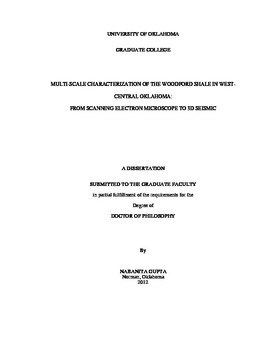| dc.contributor.advisor | Marfurt, Kurt J | |
| dc.creator | Gupta, Nabanita | |
| dc.date.accessioned | 2019-04-27T21:29:39Z | |
| dc.date.available | 2019-04-27T21:29:39Z | |
| dc.date.issued | 2012 | |
| dc.identifier | 99235124802042 | |
| dc.identifier.uri | https://hdl.handle.net/11244/318818 | |
| dc.description.abstract | This dissertation focuses on the characterization of unconventional resource-shales for resource evaluation using the Woodford Shale as a primary example for this study. The limited understanding of the actual rock properties together with the complex nature of the resource shales, demand an integrated characterization at multiple scales. In this research, I present a fully integrated characterization including petrophysical, geophysical and geological evaluation of the Woodford Shale in West Central Oklahoma, which improves the understanding about this shale as well as other resource shales. I have used a multi-scale dataset collected from multiple sources and ranging from nanometer scale scanning electron microscopic image analysis, microscopic observations made through petrographic microscope, macroscopic visual observations, laboratory measured petrophysical parameters, well-logs, to surface seismic data for regional characterization. | |
| dc.description.abstract | Driven by growing energy demand and technology advancement, resource-shales have emerged as one of the primary areas for hydrocarbon exploration. Petrophysical properties characterize both physical and mechanical properties and hence, are important for identifying sweet-spots for hydrocarbon exploration. This dissertation summarizes the petrophysical characterization of the Woodford Shale based on 300 samples collected from six hydrocarbon-producing and non-producing wells. Crushed rock porosity, bulk density, grain density, mineralogy, acoustic velocities, mercury injection capillary pressure along with total organic carbon content, rock-eval pyrolysis, and vitrinite reflectance were measured at the Integrated Core Characterization Center. NMR measurements were made on few samples to track distribution of different fluids in the pore spaces. Visual inspections were made at macroscopic-, microscopic- and scanning electron microscope-scale in order to calibrate rock-petrophysical properties with the actual rock architecture. The wide porosity range from 1% to 10% indicates different rock types with variable storage capacities. Mineralogy indicates that the Woodford is a silica-dominated silty shale with small amount of carbonate. Rock-eval analyses indicate that the Woodford Shale in two of the studied wells fall within the oil window (Ro< 1%) and four wells fall within the dry gas-condensate window (Ro>1.2%). Wells from different maturity provide an opportunity to analyze changes in petrophysical properties with changes in thermal maturity. Laboratory measured petrophysical properties were finally analyzed through cluster analyses in order to identify three rock-types characterized by unique reservoir properties. | |
| dc.description.abstract | A set of seismic attributes help to illuminate both stratigraphic and structural features present within the Woodford interval on a regional scale. I used both conventional (for example, Sobel filter similarity, most positive and most negative principal curvatures) and recently developed (for example, coherent seismic energy, most negative principal curvature modulate by azimuth, reflector rotation with respect to reflector normal) seismic attributes in this study. Petrophysical properties extracted through simultaneous inversion of the prestack seismic data allowed me to perform regional characterization of the Woodford Shale in a semi-quantitative manner. Rock types identified through the petrophysical characterization in the previous section were combined with geophysical analyses to build a regional distribution of each rock type. Finally, seismic attributes, production data along with the geologic history indicate that the basin-floor depressions are likely areas for presence of alternating TOC-rich ductile and TOC-lean brittle rock, forming potential sweet spots within the Woodford Shale. | |
| dc.description.abstract | Detailed analyses of macroscopic, microscopic and submicroscopic sedimentary features combined with the regional geologic history allowed me to build the depositional framework and associated lithofacies distribution for the Woodford Shale in the Anadarko Basin. Petrophysical measurements made on samples collected from each lithofacies present in six wells allowed me to correlate petrophysical properties with the geologic framework and identify petrophysical proxies that can be used to track stratigraphic changes in the uncored areas. This study reveals that mineralogy is one of the important tools for tracking the geologic history. Since mineralogy correlates well with other petrophysical properties, one can correlate the petrophysical properties of the Woodford Shale based on the geologic framework and thus can improve on the accuracy of well-placement and future exploration activities. | |
| dc.format.extent | 181 pages | |
| dc.format.medium | application.pdf | |
| dc.language | en_US | |
| dc.relation.requires | Adobe Acrobat Reader | |
| dc.subject | Woodford Shale (Okla. and Texas) | |
| dc.subject | Shale oils--Oklahoma | |
| dc.subject | Petrology | |
| dc.subject | Shale--Oklahoma | |
| dc.title | MULTI-SCALE CHARACTERIZATION OF THE WOODFORD SHALE IN WEST-CENTRAL OKLAHOMA: FROM SCANNING ELECTRON MICROSCOPE TO 3D SEISMIC | |
| dc.type | text | |
| dc.type | document | |
| dc.thesis.degree | Ph.D. | |
| ou.group | Mewbourne College of Earth and Energy::ConocoPhillips School of Geology and Geophysics | |
